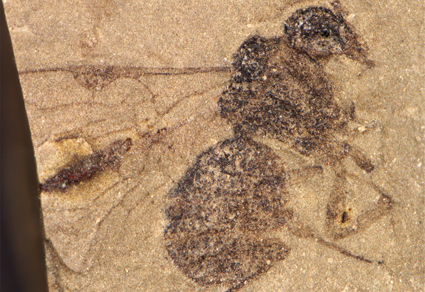Abstract
Baissid wasps (Hymenoptera: Baissidae) represent a family within the superfamily Evanioidea composed of 36 species in seven genera restricted to a period spanning from the Berriasian (earliest Cretaceous) to the Turonian (early Late Cretaceous). The status and rank of the family have been changing over time, and recent phylogenetic analyses indicate that Baissidae may be paraphyletic to Aulacidae + Gasteruptiidae. The genus Manlaya Rasnitsyn, 1980 is the most diverse and widespread in the family, including representatives from western and eastern Laurasia. Here, we describe Manlaya minima sp. nov. from the Lower Cretaceous Shouchang Formation (Zhejiang Province, China). The new species has elbowed second medial cell, similar to Electrobaissa Engel, 2013, although the rest of the characters match with Manlaya, indicating that this character might be related to interspecific variability rather than differences between genera. The co-occurrence of Manlaya in the contemporaneous Shouchang Formation and the Jehol biota may point to a connection between the two entomofaunas. A key to the species of the family Baissidae from China is provided.
References
- Álvarez-Parra, S. & Azar, D. (2024) The wasps (Hymenoptera) from Lower Cretaceous Lebanese and Spanish ambers. Fossil Studies, 2, 110–122. https://doi.org/10.3390/fossils2020005
- Cockerell, T.D.A. (1917) Fossil insects. Annals of the Entomological Society of America, 10, 1–22. https://doi.org/10.1093/aesa/10.1.1
- Engel, M.S. (2013) A new genus and species of Baissidae in Late Cretaceous amber from New Jersey (Hymenoptera: Evanioidea). Novitates Paleoentomologicae, 3, 1–8. https://doi.org/10.17161/np.v0i3.4570
- Grimaldi, D.A. & Engel, M.S. (2005) Evolution of the insects. Cambridge University Press, New York, 755 pp.
- Hakim, M., Azar, D., Cai, C., Gao, J. & Huang, D. (2023) Paraprotopsyllidium, a protopsyllidioid genus from the mid-Cretaceous Burmese amber, now discovered in the Lower Cretaceous (Barremian) Shouchang Formation, Zhejiang Province, East China. Cretaceous Research, 150, 105608. https://doi.org/10.1016/j.cretres.2023.105608
- Hong, Y.C. & Wang, W.L. (1990) Fossil insects from the Laiyang Basin, Shandong Province. In: The Regional Geological Surveying Team, Shandong Bureau of Geology and Mineral Resources (Eds), The stratigraphy and paleontology of Laiyang Basin, Shandong Province. Geological Publishing House, Beijing, 157–158. [in Chinese].
- Huang, D., Fu, Y., Lian, X., Gao, J. & Nel, A. (2022) The oldest malachite damselfly (Odonata: Synlestidae) from the Lower Cretaceous of China. Cretaceous Research, 129, 105023. https://doi.org/10.1016/j.cretres.2021.105023
- Jouault, C., Maréchal, A., Condamine, F.L., Wang, B., Nel, A., Legendre, F. & Perrichot, V. (2022) Including fossils in phylogeny: a glimpse into the evolution of the superfamily Evanioidea (Hymenoptera: Apocrita) under tip-dating and the fossilized birth–death process. Zoological Journal of the Linnean Society, 194 (4), 1396–1423. https://doi.org/10.1093/zoolinnean/zlab034
- Latreille, P.A. (1802) Histoire naturelle, générale et particulière des crustacés et des insectes, tome troisième. L’imprimerie de F. Dufart, Paris, 394 pp. https://doi.org/10.5962/bhl.title.15764
- Li, L., Rasnitsyn, A.P., Shih, C., Labandeira, C.C., Buffington, M., Li, D. & Ren, D. (2018) Phylogeny of Evanioidea (Hymenoptera, Apocrita), with descriptions of new Mesozoic species from China and Myanmar. Systematic Entomology, 43 (4), 810–842. https://doi.org/10.1111/syen.12315
- Li, L., Shih, C., Li, D. & Ren, D. (2019) New fossil species of Ephialtitidae and Baissidae (Hymenoptera, Apocrita) from the mid-Mesozoic of northeastern China. Alcheringa, 43, 568–579. https://doi.org/10.1080/03115518.2019.1601767
- Lin, Q.B. (1980) Mesozoic insects from Zhejiang and Anhui provinces. In: Nanjing Institute of Geology and Palaeontology, Chinese Academy of Sciences (Ed.), Division and correlation of the Mesozoic volcano-sedimentary strata in Zhejiang and Anhui provinces. Science Press, Beijing, 211–234. [in Chinese].
- Mason, W.R.M. (1993) Superfamilies Evanioidea, Stephanoidea, Megalyroidea, and Trigonalyoidea. In: Goulet, H. & Huber, J.T. (Eds), Hymenoptera of the world: An identification guide to families. Agriculture Canada, Ottawa, pp. 510–520.
- Rasnitsyn, A.P. (1975) Hymenoptera Apocrita of the Mesozoic. Trudy Paleontologicheskogo Instituta Akademii Nauk SSSR, 147, 1–134. [in Russian].
- Rasnitsyn, A.P. (1980) On the system of the family Aulacidae (Hymenoptera) in connection with a new finding in the Lower Cretaceous of Manlay. Trudy Sovmestnoy Sovetsko-Mongol’skoy Paleontologicheskoy Ekspeditsii, 13, 65–67. [in Russian].
- Rasnitsyn, A.P. (1986) Vespida (=Hymenoptera). In: Tatarinov L.P., Afanasyeva, G.A., Barsbold, R., Morosowa, I.P, Novitskaya, L.I., Reshetov, V.Y., Rosanov, A.Y., Sysoev, V.A., Trofimov, B.A. & Rasnitsyn, A.P. (Eds.), Insects in the Early Cretaceous ecosystems of the West Mongolia. Trudy Sovmestnoy Sovetsko-Mongol’skoy Paleontologicheskoy Ekspeditsii, 28, pp. 154–164. [in Russian].
- Rasnitsyn, A.P. (1990) Hymenoptera. In: Rasnitsyn, A.P. (Ed.), Late Mesozoic insects of eastern Transbaikalia. Trudy Paleontologicheskogo Instituta Akademii Nauk SSSR, 239, pp. 177–205. [in Russian].
- Rasnitsyn, A.P. & Ansorge, J. (2000) New Lower Cretaceous hymenopterous insects (Insecta: Hymenoptera) from Sierra del Montsec, Spain. Acta Geologica Hispanica, 35, 59–64.
- Rasnitsyn, A.P. & Martínez-Delclòs, X. (2000) Wasps (Insecta: Vespida =Hymenoptera) from the Early Cretaceous of Spain. Acta Geologica Hispanica, 35, 65–95.
- Rasnitsyn, A.P., Jarzembowski, E.A. & Ross, A.J. (1998) Wasps (Insecta: Vespida =Hymenoptera) from the Purbeck and Wealden (Lower Cretaceous) of southern England and their biostratigraphical and palaeoenvironmental significance. Cretaceous Research, 19, 329–391. https://doi.org/10.1006/cres.1997.0114
- Ren, D., Lu, LW., Guo, Z.G. & Ji, S.A. (1995) Faunas and stratigraphy of Jurassic–Cretaceous in Beijing and adjacent areas. Seismic Publishing House, Beijing, 265 pp. [in Chinese].
- Zhang, H.C. (2021) Re-description of the Cretaceous wasp Humiryssus leucus Lin, 1980 (Hymenoptera: Evanioidea: Baissidae). Palaeoentomology, 4 (5), 425–428. https://doi.org/10.11646/palaeoentomology.4.5.5
- Zhang, J.F. & Rasnitsyn, A.P. (2004) Minute members of Baissinae (Insecta: Hymenoptera: Gasteruptiidae) from the Upper Mesozoic of China and limits of the genus Manlaya Rasnitsyn, 1980. Cretaceous Research, 25, 797–805. https://doi.org/10.1016/j.cretres.2004.08.001


